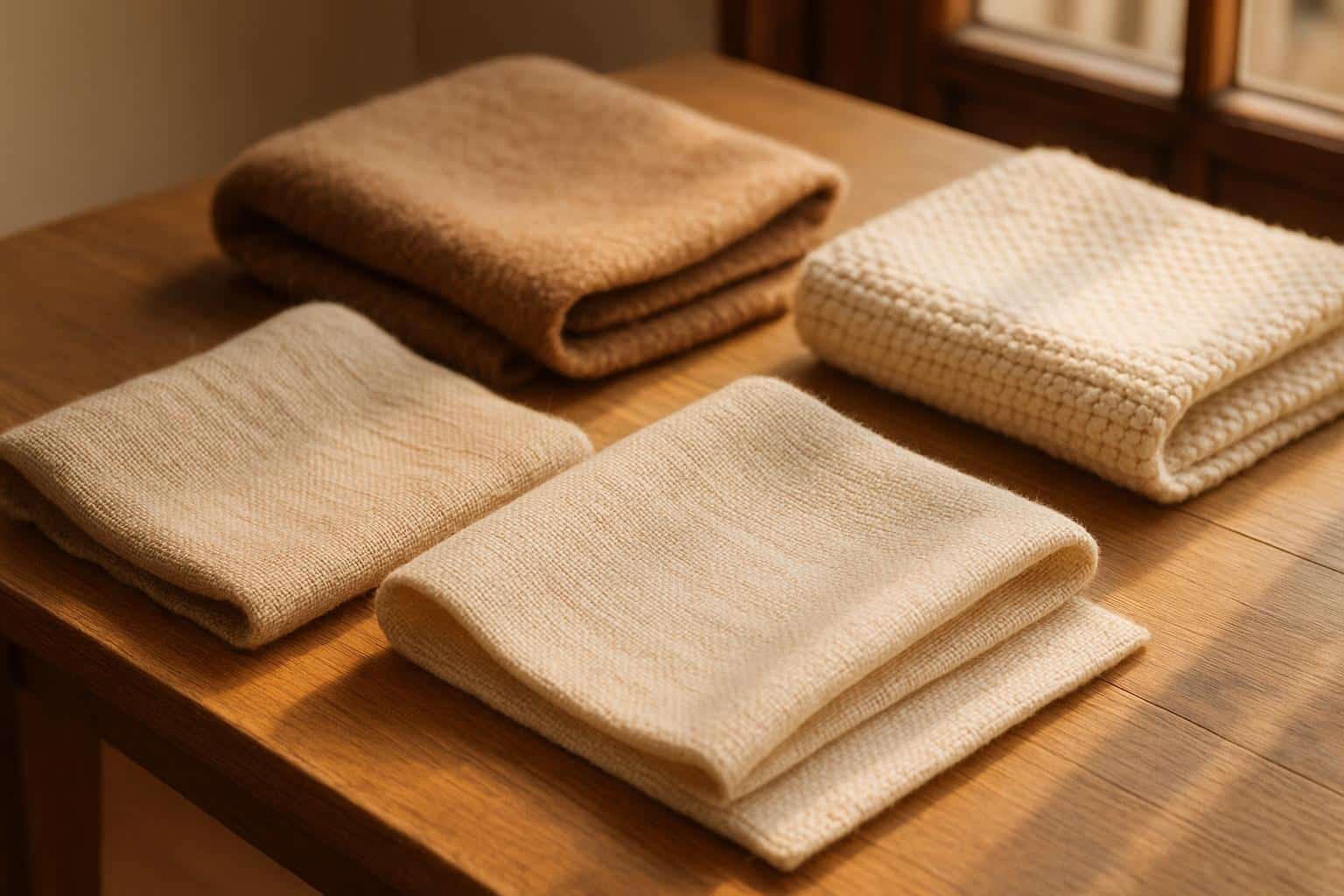When thrifting, choosing natural fabrics like cotton, linen, wool, and silk is a smart way to prioritize comfort, reduce waste, and avoid synthetic materials that shed microplastics. These fabrics are breathable, durable, and biodegradable, making them a better option for both personal use and the planet. Here’s how to identify them:
- Check Labels: Look for tags that say “100% cotton”, “linen”, “wool”, or “silk.” Certifications like OEKO-TEX® or GOTS can also confirm eco-friendly standards.
- Feel the Texture: Natural fabrics have distinct textures – cotton is soft, linen is crisp, silk is smooth, and wool varies from soft to coarse.
- Observe Aging: Natural fabrics age gracefully, softening or developing unique textures, unlike synthetics that often look stiff or shiny over time.
- Burn Test (Optional): For unlabeled items, burning a small fabric edge can help – natural fibers burn like paper, while synthetics melt.
Shopping second-hand natural fabrics not only extends the life of clothing but also minimizes landfill waste and supports local thrift stores like City Thrift, which funds community programs.
What Natural Fabrics Are and Why They Matter
What Are Natural Fabrics?
Natural fabrics come from renewable sources like plants (think cotton and linen) and animals (like wool and silk). These materials have been part of human life for thousands of years. Unlike synthetic fibers, which are made from petrochemicals, natural fibers stand out for their texture, comfort, durability, and impact on the environment.
Each fabric has its unique qualities. Cotton, for instance, is soft and smooth, while linen is known for its textured, irregular weave. Wool provides natural insulation and moisture control, and silk is prized for its luxurious smoothness. Knowing where these fabrics come from helps us appreciate their value.
Why Pick Natural Fabrics?
Natural fabrics aren’t just about their origins – they offer practical and environmental benefits that make them a smart choice. For one, they’re incredibly comfortable and breathable, keeping you cool and dry. Unlike synthetic materials that can trap moisture, natural fabrics like merino wool absorb and release moisture vapor and even resist odors naturally.
Durability is another perk. With proper care, natural fabrics can last for years, often becoming softer with each wash. And when they do show wear, they’re easier to repair. Compare that to synthetic fibers, which are more prone to pilling and damage that can’t be fixed. For those with sensitive skin, natural fabrics are a gentle option – they’re hypoallergenic and less likely to irritate.
From an environmental standpoint, natural fibers have a clear edge. They’re biodegradable, breaking down naturally and enriching the soil. On the flip side, synthetic fabrics, made from fossil fuels, can linger in landfills for centuries – polyester, for example, can take up to 200 years to decompose. That said, not all natural fabric production is free from environmental concerns. For example, growing conventional cotton requires a significant amount of water – over 2,700 liters for just one t-shirt – and accounts for around 16% of global insecticide use. Opting for quality natural fabrics through second-hand shopping can extend the life of garments and reduce the need for new production.
As the 1404 Collective puts it:
“Natural fibers are not only kinder to the planet, but they also feel better on your skin and last longer.”
How to Find Natural Fabrics When Thrift Shopping
Thrifting is a treasure hunt, and spotting natural fabrics is all about using your senses and a bit of detective work. By paying attention to labels, textures, and signs of wear, you can uncover high-quality pieces that are both stylish and sustainable.
Check the Clothing Labels
Labels are your first clue. Look for ones that state “100% cotton”, “linen”, or “wool.” These are clear indicators of natural fibers.
If you’re browsing older garments, the tags might be faded or missing altogether. In those cases, you’ll need to rely on other signs to identify the fabric. While you’re at it, keep an eye out for certifications like OEKO-TEX®, GOTS, or Fair Trade Certified™. These labels not only confirm fabric content but also indicate that the item meets certain environmental and ethical standards.
Feel the Fabric
Your sense of touch is a powerful tool. Natural fabrics each have a unique feel:
- Cotton: Soft and smooth to the touch.
- Linen: Crisp with a slightly textured surface.
- Silk: Smooth and cool, almost luxurious.
- Wool: Can range from soft to coarse, but is always breathable and moisture-absorbing.
On the other hand, synthetic fabrics often feel slick or, in cheaper versions, stiff and scratchy. They tend to trap heat and moisture, which makes them less comfortable compared to the breathability of natural fibers.
Assess Garment Aging
The condition of a garment can also reveal its fabric type. Natural fabrics age gracefully – cotton softens with repeated washes, linen develops a relaxed texture, and wool holds up while maintaining its insulating properties. These subtle changes add character and comfort over time.
In contrast, synthetic materials often stay stiff or retain a shiny, artificial look, even after years of wear. By learning to spot these differences, you can make more informed choices, picking pieces that not only last but also align with sustainable shopping habits.
Why Shopping for Natural Fabrics at City Thrift Helps
Choosing natural fabrics from City Thrift not only supports sustainable fashion but also strengthens Kansas City’s community programs. Every purchase makes a difference – for the planet and those in need.
Help the Environment and Cut Down on Waste
Shopping for natural fabrics at City Thrift plays a role in reducing textile waste. In the U.S., over 11 million tons of textiles are dumped into landfills every year. When you pick up a 100% cotton sweater or a linen dress, you’re extending the life of quality clothing and keeping it out of the trash.
The environmental cost of producing new clothing is massive. Fast fashion alone contributes to nearly 10% of global carbon emissions. Plus, the production of new garments consumes staggering amounts of water – 2,700 liters for just one cotton t-shirt and 1,800 gallons for a pair of jeans. Opting for second-hand natural fabrics means skipping these resource-intensive processes. And with only 15% of consumer textiles being recycled, while 85% end up in landfills or are burned, every purchase of pre-loved clothing helps to curb this wasteful trend.
But the impact doesn’t stop with the environment – your thrift store finds also strengthen local community programs.
Help Your Community Through City Thrift
Every dollar spent at City Thrift directly supports Kansas City programs. Proceeds from the store benefit City Union Mission, funding essential services such as food, clothing, shelter, education, and more for those in need. Whether you snag a wool blazer or a vintage cotton dress, your purchase helps sustain these vital efforts.
City Union Mission offers a range of programs, including Men’s Biblical Counseling, Career Development, and the Homeless Men’s Ministry. They also provide life skills classes, after-school programs like City Corps, and youth-focused initiatives such as Camp CUMCITO and Shelter Tutoring at the Vanderberg Youth Center.
“Thrift shopping slows down this harmful cycle. It keeps perfectly good items circulating instead of fueling the need for new production. Plus, thrift shopping often supports local charities, community programs, and eco-friendly initiatives, making it a win for everyone involved.” – City Thrift
Shop Smart for Natural Fabrics
Spotting natural fabrics while thrifting doesn’t have to be complicated. Start by checking labels for materials like cotton, linen, wool, or silk. Next, rely on your senses – touch the fabric and notice how it has aged. Natural fibers tend to feel softer and show wear differently than synthetics.
If you’re still unsure, try a simple burn test. For unlabeled items, burn a small edge of the fabric. Natural fibers burn like paper and leave soft ashes, while synthetic materials melt and curl. Combining this method with the tips above will help you consistently choose natural, eco-friendly fabrics.
Shopping at City Thrift does more than just reduce textile waste – it keeps millions of pounds of clothing out of landfills. It also directly supports Kansas City community programs through City Union Mission.
FAQs
How can I tell if a fabric is natural or synthetic when there’s no label?
If the clothing label is missing or too worn to read, there are a couple of easy ways to figure out if the fabric is natural or synthetic. Start by checking the texture and how it wrinkles. Natural fabrics like cotton, linen, or wool usually feel softer, wrinkle more, and hold creases. On the other hand, synthetic materials like polyester or nylon tend to be smoother and resist wrinkling.
You can also try the burn test – but only if it’s safe to do so! Carefully burn a small thread or edge of the fabric. Natural fibers typically burn slowly, leaving behind charred residue, and they smell like burning hair or paper. Synthetic fibers, however, melt quickly and release a chemical or plastic-like odor.
Looking for second-hand clothing made from all kinds of fabrics? Check out City Thrift. It’s a great way to find one-of-a-kind pieces while making an eco-friendly choice and supporting your local community!
Why is it better for the environment to choose natural fabrics instead of synthetic ones when thrifting?
When thrifting, choosing natural fabrics like cotton, wool, or linen over synthetic ones can have a big environmental impact. Natural fibers break down naturally over time because they’re biodegradable, unlike synthetic materials such as polyester or nylon, which can linger in landfills for hundreds of years.
On top of that, producing natural fabrics often requires less energy and fewer chemicals compared to synthetics. By picking second-hand natural fabrics, you’re cutting down on waste while promoting a more environmentally conscious way of living.
How does shopping at City Thrift benefit the community and support sustainability?
When you shop at City Thrift, you’re doing more than just finding great deals – you’re giving back to your community. The proceeds from your purchases help support vital programs like homelessness and poverty relief through City Union Mission. Plus, buying second-hand helps cut down on textile waste, promotes resource reuse, and encourages eco-friendly shopping habits. By choosing City Thrift, you’re making a difference for both the planet and the people around you.






